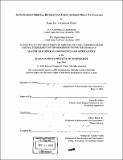Autonomous orbital rendezvous using angles-only navigation
Author(s)
Chari, Raja Jon Vurputoor, 1977-
DownloadFull printable version (13.03Mb)
Other Contributors
Massachusetts Institute of Technology. Dept. of Aeronautics and Astronautics.
Advisor
David K. Geller.
Terms of use
Metadata
Show full item recordAbstract
This study assesses navigation performance for rendezvous and close approach applications where on-board navigation must be accomplished through the use of angles-only measurements by developing various relative motion orbital trajectories. Chaser vehicle maneuvers designed to enhance the estimator's observability of the downrange distance to the target are considered. The target vehicle is assumed to be non-maneuvering and in a near-circular orbit. The modeled system includes representative scenarios from the Orbital Express mission. Although a wide array of angle measurement sensors are available, their use in orbital rendezvous is generally limited by the fact that they are unable to provide direct target ranging information which leads to significant downrange error accumulation in the navigation filter. These navigation problems inherent to angles-only measurements in a natural motion environment are first qualitatively studied both analytically and through linear covariance modeling. It is shown that different target-chaser geometries lead to different navigation uncertainties in target downrange distance. The conclusions drawn from considering natural motion geometries are used to study candidate maneuver-assisted trajectories. The results from this study are used to select and combine the most promising maneuver-assisted trajectories for more in-depth consideration as potential scenarios for the Orbital Express mission. These selected trajectories are then analyzed in depth to determine the interdependency of range observability using angles-only navigation with angular sensor quality, inertial measurement accuracy, attitude determination accuracy, and trajectory design. Using the Orbital Express mission as a baseline, maneuver-assisted trajectories for angles-only navigation are tested with realistic error models to validate the rules of thumb created for improved angles-only navigation even in the presence of biases, misalignments, and degraded sensors. The results show that using well-chosen trajectories leads to navigation error uncertainties acceptable for rendezvous applications when only angular measurements are available.
Description
Thesis (S.M.)--Massachusetts Institute of Technology, Dept. of Aeronautics and Astronautics, 2001. Includes bibliographical references (p. 193-195).
Date issued
2001Department
Massachusetts Institute of Technology. Department of Aeronautics and AstronauticsPublisher
Massachusetts Institute of Technology
Keywords
Aeronautics and Astronautics.